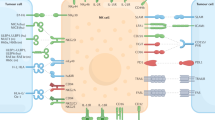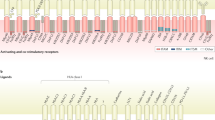Abstract
Natural killer (NK) cells have unique surface features and physiological characteristics and a selective ability to lyse some, but not other, target cells1,2. However, the basis of this selectivity remains obscure at both effector and target cell levels. Proposed specific NK-cell target moieties3–5 include glycolipids, and glycoproteins unrelated to the major histocompatibility complex, while malignant and certain normal cells have been found to be susceptible to NK-cell-mediated cytolysis6–8. There is good evidence that NK cells can inhibit the outgrowth of small numbers of transplanted tumour cells in vivo9,10 and can restrict the establishment of secondary metastasis11,12. It has thus been speculated that NK cells function as a primitive, thymus-independent immune system using phylogenetically preserved target structures to form a cell-mediated resistance barrier against the outgrowth of certain tumour cells1. The presence in the thymuses of neonatal mice and humans8,13 and in the marrow of human fetuses, of apparently normal cells which are quite sensitive to NK cells suggested that NK cells might have an increased ability to cause the lysis of cells at a particular stage of their differentiation. In agreement with this concept, embryonal carcinoma cells at various stages of differentiation display a strikingly different susceptibility to NK-cell-induced lysis14. Here only cell types representing early stages were sensitive to NK-cell-mediated cytolysis, whereas the more differentiated endodermal cell lines showed close to complete resistance. The above data would thus support the view that, in vivo, depending on the stage of differentiation, both normal and malignant cells are under surveillance by NK cells. Here we have considered the question of differentiation-related NK-cell susceptibility using defined cell lines known to undergo controlled differentiation in the presence of various agents. Three tumour cell-lines were investigated, and all demonstrated a striking positive correlation between a decrease in NK-cell susceptibility and the induction of differentiation by the various inducers. Our findings support the view that susceptibility to NK-cell mediated lysis may vary according to the stage of differentiation of the target cell.
This is a preview of subscription content, access via your institution
Access options
Subscribe to this journal
Receive 51 print issues and online access
$199.00 per year
only $3.90 per issue
Buy this article
- Purchase on Springer Link
- Instant access to full article PDF
Prices may be subject to local taxes which are calculated during checkout
Similar content being viewed by others
References
Kiessling, R. & Wigzell, H. Immun. Rev. 44, 165–208 (1979).
Herberman, R. B. (ed.) Natural Cell-Mediated Immunity Against Tumours (Academic, New York, 1980).
Roder, J. C. Ährlund-Richter, L. & Jondal, M. J. exp. Med. 150, 471–480 (1979).
Young, W. W., Durdik, J. M., Urdal, D., Hakomori, S.-I. & Henney, C. S. J. Immun. 126, (1981).
Kiessling, R. & Wigzell, H. Curr. Topics Microbiol. Immun. (in the press).
Kiessling, R., Klein, E. & Wigzell, H. Eur. J. Immun. 5, 112–117 (1975).
Cudkowicz, G. & Hochman, P. S. Immun. Rev. 44, 13–41 (1979).
Hansson, M., Kiessling, R., Andersson, B., Kärre & Roder, J. Nature 278, 174–176 (1979).
Haller, O., Hansson, M., Kiessling, R. & Wigzell, H. Nature 270, 609–611 (1977).
Riesenfeldt, I. et al. Int. J. Cancer 25, 399–403 (1980).
Talmadge, J., Meyers, K., Prieur, D. & Starkey, J. Nature 284, 622–624 (1980).
Hanna, N. & Fiddler, I. J. natn. Cancer Inst. (in the press).
Hansson, M. & Kiessling, R. in NK Cells: Fundamental Aspects and Role in Cancer (ed. Herberman, R. B.) (North-Holland, Amsterdam, in the press).
Stern, P., Gidlund, M., Örn, A. & Wigzell, H. Nature 285, 341–342 (1980).
Andersson, L. C., Jokinen, M. & Gahmberg, C. G. Nature 278, 364–365 (1979).
Pattengale, P. K. et al. Int. J. Cancer (in the press).
Sundström, C. & Nilsson, K. Int. J. Cancer 17, 565–577 (1976).
Nilsson, K. et al. Mod. Trends Hum. Leukaemia 26 (in the press).
Koren, H. S., Andersson, S. J. & Larrick, J. W. Nature 279, 328–331 (1979).
Nilsson, K., Andersson, L. C., Gahmberg, C. G. & Forsbeck, K. in New Trends in Human Immunology and Cancer Immunotherapy (eds Serrou, B. & Rosenfeld, C.) 271–282 (Doin, Paris, 1981).
Gazitt, Y., Reuben, R., Deitch, A., Marks, P. & Ritkind, R. Cancer Res. 38, 3779–3785 (1978).
Persson, H., Jansson, M. & Philipson, L. J. molec. Biol. 136, 375–394 (1980).
Nilsson, K., Evrin, P. E. & Welsh, K. I. Transplantn Rev. 21, 53–84 (1974).
Blazar, B., Patarroyo, M., Klein, E. & Klein, G. J. exp. Med. 151, 614–627 (1980).
Author information
Authors and Affiliations
Rights and permissions
About this article
Cite this article
Gidlund, M., Örn, A., Pattengale, P. et al. Natural killer cells kill tumour cells at a given stage of differentiation. Nature 292, 848–850 (1981). https://doi.org/10.1038/292848a0
Received:
Accepted:
Issue Date:
DOI: https://doi.org/10.1038/292848a0
This article is cited by
-
Role of catalase in monocytic differentiation of U937 cells by TPA: hydrogen peroxide as a second messenger
Leukemia (2009)
-
BLIMP-1: trigger for differentiation of myeloid lineage
Nature Immunology (2000)
-
Colchicine inhibits integrin α5β1 gene expression during PMA-induced differentiation of U937 cells
Archives of Pharmacal Research (1995)
-
Effects of antineoplastic phospholipids on parameters of cell differentiation in U937 cells
Journal of Cancer Research and Clinical Oncology (1990)
-
Sensitivity of glioma and fetal brain cell lines to natural killer cytolysis in a monolayer assay
Journal of Neuro-Oncology (1989)
Comments
By submitting a comment you agree to abide by our Terms and Community Guidelines. If you find something abusive or that does not comply with our terms or guidelines please flag it as inappropriate.



